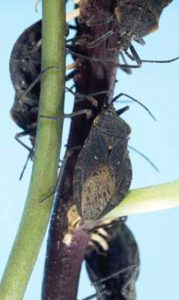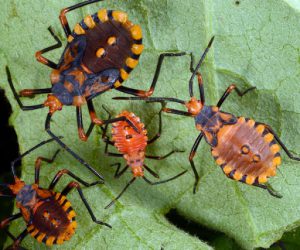While tending to your garden, you’ve undoubtedly come across a variety of peculiar looking insects throughout the growing season. Especially noteworthy are those which belong to the leaf-footed bug family, Coreidae. Owing to their size, and in some cases color, it’s easy to see why they’re so striking and frequently noticed by gardeners.

An example includes the giant sweet potato bug (Spartocera batatas). Native to Surinam and the Caribbean islands, they were first discovered in Florida in 1995 on an Asian cultivar of sweet potato from a residential garden. Although considered a minor pest of commercial sweet potato production in Puerto Rico and Cuba, surrounding areas of commercial sweet potato production in Florida were surveyed following its initial discovery, with no further infestations found. So, while they may find their way into your home garden, it is unlikely they will become a major pest of commercial fields.
Giant sweet potato bug adults are entirely dark brown, while their nymphs are bright red. Their eggs are shaped like tiny sausages and colors range from gold to brown. Their primary plant host is, of course, sweet potato (Ipomoea batatas). Still, records have shown this pest to feed on other members of the family Solanaceae such as tomato, eggplant, and potato, as well as avocado and some Citrus species.

A more common species found in Florida home gardens is Spartocera fusca. Native to Mexico, the Caribbean, and areas of the continental U.S., their preferred host plants are black night shade (Solanum americanum) and the ground cherry (Physalis spp.). Adults can be distinguished from the dark brown sweet potato bug, as they are black and yellowish orange with bold markings.
Again, these pests do not seem to be a major issue of concern for residential or commercial level cultivation of Solanaceous crops here in Florida. Adults can be easily managed through physical removal while scouting for pests. If you think you have an infestation of this bug type in your garden, revisit your seasonal planting dates and be sure to remove the suitable crop host at the end of it’s growing season. Additionally, encouraging beneficial insects and predators, like birds, by limiting pesticide use is also important. For more information on identifying these bugs and managing potential pests in your garden contact your local county extension office.
 6
6
